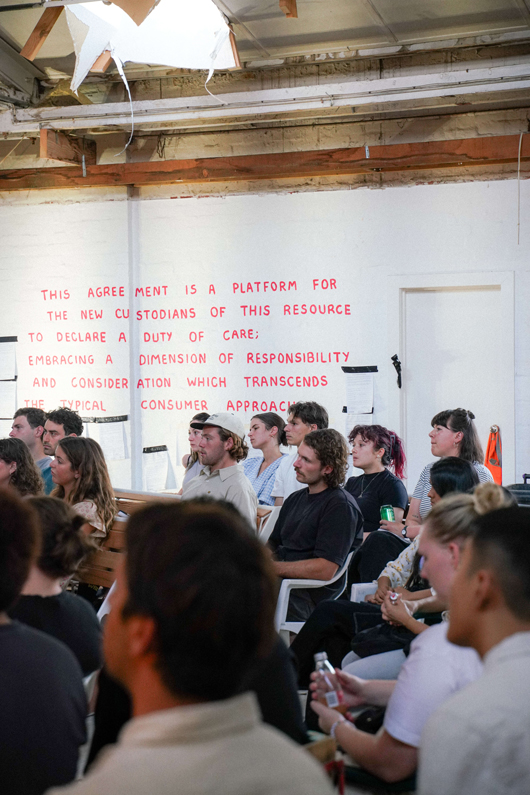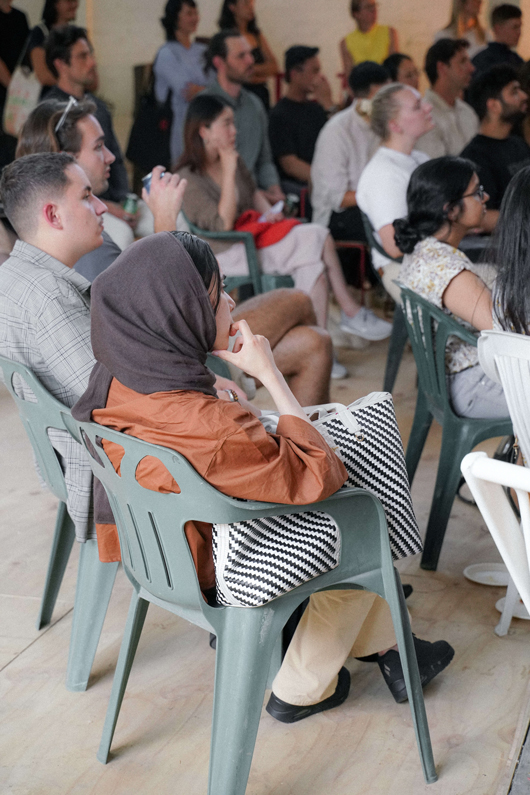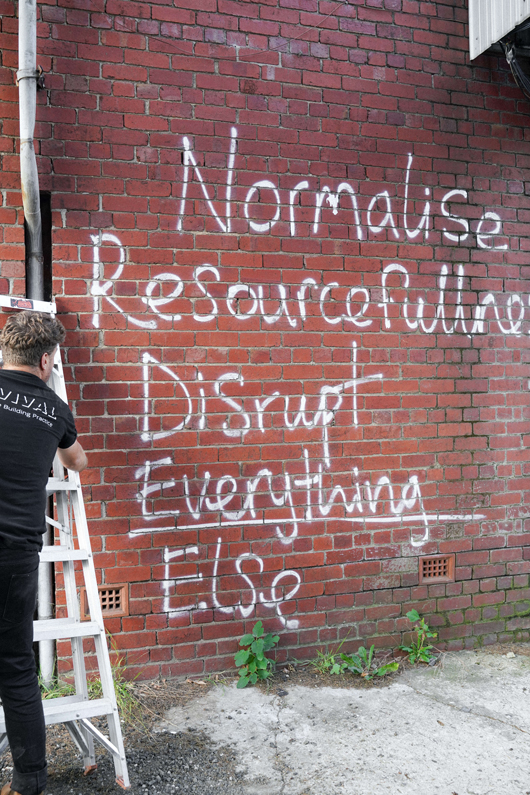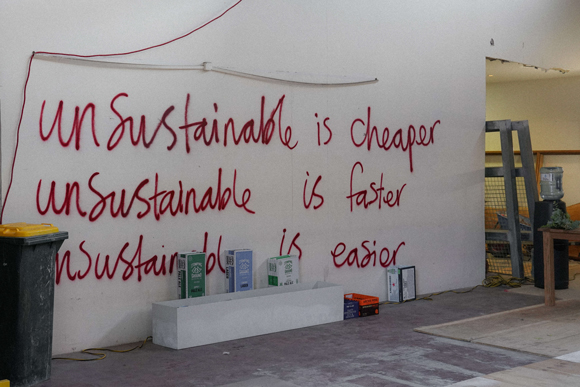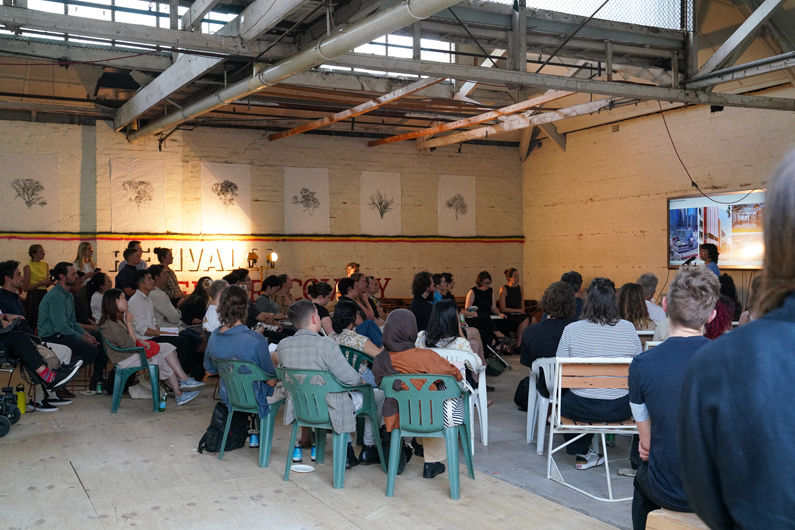
Among various offcuts and salvaged material waste, an open conversation around circular building, non-destructive construction and regenerative waste occurred. EmAGN Victoria’s first chapter event for 2024, donating all profits to Indigenous organisation, Fire Sticks, was held on March 18 in collaboration with multidisciplinary practice, Revival Projects at their warehouse in Collingwood. The venue’s once-white painted brick walls were transformed over the course of the evening, spray painted in red with statements of provocation and marked by many handprints of attendees, pledging allegiance to the land.
Four insightful local and international speakers put forward several provocations for both industry and society. They asked the audience whether architects can reshape their processes, values, and design practice to place more value on existing buildings and materials. They questioned, does a practitioner and their clients’ values always align? How can we better respect all stakeholders in the circularity journey? Essentially, the event begged the question, can architects shift from the modus operandi of the linear to a more circular, regenerative future?
Lucy Marsland of Atelier Ten opened the conversation clarifying some often-misunderstood definitions of material circularity. Drawing from personal experience, Marsland reflected on the importance of embracing a more holistic lifecycle perspective towards material circularity, moving away from solely focusing on the upfront actions that can be taken. Deeming the need to future-cast and set up the framework for positive end-of-life actions as critical, Marsland challenged the audience to consider “how we can set up the end of life of a building for success”. She urged attendants to think of it “not as the end of life, but rather, the beginning of a second, third or even fourth life”. To achieve this, Marsland noted the need for all stakeholders to respect each other’s skills, motivations, and experiences – from tradespeople to clients – as circularity is a journey that requires buy-in from all sides.
Many projects that aim for material circularity also come with a challenge of working with diverse stakeholders. Mastura Mokhtar, associate at Six Degrees Architects, delved into the significance of shared values among stakeholders when implementing environmentally sustainable design practices. Highlighting factors such as cost, regulatory constraints and even aesthetic considerations as being barriers to material circularity, Mokhtar shared her experiences as being difficult, and often untraditional. The complexity inherent in project teams can also be a limiting factor, with Mokhtar noting how in “a project with multiple stakeholders, it can be quite challenging to get a decision across because you’ve got multiple people involved with different aspects or criteria that they’re interested in”. Mokhtar continued to contemplate the importance of a common vision for any project, stressing its critical role in delivering better outcomes for process, project, and the broader environment.
Shifting the conversation from process to materials, Robbie Neville, founder of Revival Projects, articulated the importance of timing and custodianship in the journey towards material circularity. Although Neville acknowledged that “the hard moment comes with selecting who to work with”, he emphasised the importance of timing when it comes to integrating material resources into the design process: “the timing of when we think about resources, at the moment, only really starts to happen after the design is developed, but we need to completely change that juncture of when we think about resources,” he says. Challenging the audience to consider making a declaration to our clients in the beginning on how resources and materials will be used, Neville encouraged attendees to reframe the value of materials in the economy and to consider adopting the position of individuals and organisations as custodians, rather than consumers, in the way we work with and for our planet’s resources.
To bring an international lens to the conversation, Rotterdam-based Césare Peeren of Superuse Studio and Superuse On-site was invited to share his own pioneering work. Dedicating the last 26 years of his practice to the advancement of the architectural process, Peeren has worked with a strong emphasis on the use of materials and resources. The topic of values once again emerged when Peeren shared the vision Superuse Studio adopted at the beginning of their practice. “We won’t take any jobs unless they fit with our philosophy,” said Peeren, sharing that “we don’t want to be a part of this weird economy. We don’t want to damage the planet even more”. Exhibiting projects that embodied this value, Peeren showed a diverse array of small-scale installations, material explorations based in play, interiors, housing, and community-based projects. A common thread across all typologies was changing the way we design: Peeren challenged the practitioners in the room to ask – do we need to build a new building, or can we retrofit the existing stock using waste materials?
Discussions continued well into the night, brimming with passionate and empowering conversations on how to better engage with the transformative change our industry needs to wholly embrace the opportunities and challenges that come with material circularity in architecture.
Panel
Lucy Marsland – Senior Environmental Designer, Atelier Ten
Mastura Mokhtar – Associate, Six Degrees Architects
Robbie Neville – Founder, Revival Sustainable Practice
Césare Peeren (S.os) – Co-founder, Superuse Studios
Event hosted by Hilary Duff and Katie Skillington
Sponsor Fielders
Photography by Elizabeth Campbell
